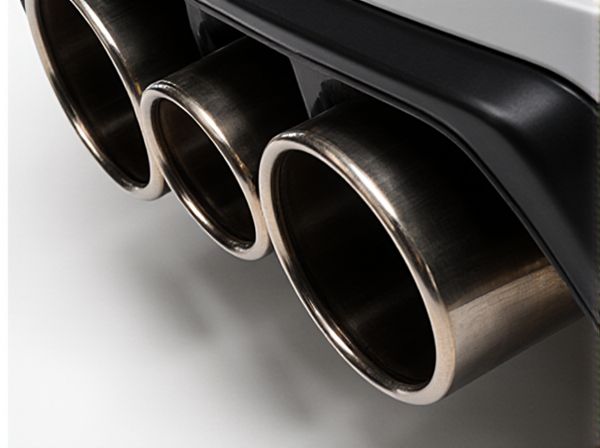
Photo illustration: Shorty header vs Long tube header
Shorty headers offer a compact design that improves exhaust flow and increases horsepower in tight engine bays, making them ideal for street performance and daily driving. Long tube headers extend further from the engine, enhancing exhaust scavenging and boosting power at higher RPMs, which benefits racing and high-performance builds. Your choice depends on the balance between space constraints and desired power gains.
Table of Comparison
| Feature | Shorty Header | Long Tube Header |
|---|---|---|
| Length | Short, fits close to the engine | Long, extends towards the exhaust system |
| Horsepower Gain | Moderate increase | Significant increase |
| Torque Improvement | Minimal to moderate | Better low-end and mid-range torque |
| Installation | Easy, bolt-on | Complex, may require modifications |
| Cost | Lower price | Higher price |
| Emissions Compliance | Typically OEM compliant | Potentially non-compliant, needs O2 sensor relocation |
| Exhaust Sound | Moderate change | Deeper, more aggressive tone |
| Heat Management | Higher engine bay heat | Better heat dispersion |
Introduction to Exhaust Headers
Exhaust headers improve engine performance by optimizing exhaust gas flow from the engine cylinders to the exhaust system. Shorty headers feature a compact design with shorter primary tubes, providing quicker exhaust scavenging and better low to mid-range torque. Long tube headers have extended primary tubes that enhance exhaust flow velocity, resulting in increased horsepower and improved high-RPM performance.
What Are Shorty Headers?
Shorty headers are exhaust manifolds designed with shorter primary tubes that improve low to mid-range torque and offer easier installation in tight engine bays. These headers typically provide better ground clearance and are popular in muscle cars and street performance vehicles. Compared to long tube headers, shorty headers sacrifice some high-end horsepower for enhanced throttle response and drivability at lower RPMs.
What Are Long Tube Headers?
Long tube headers are exhaust components designed with extended primary tubes that improve engine efficiency by enhancing exhaust gas flow and increasing horsepower. They optimize scavenging effects, which helps in better cylinder evacuation and boosts overall engine performance, especially at higher RPMs. Compared to shorty headers, long tube headers offer significant gains in torque and horsepower due to their length and tuning, making them ideal for performance-focused vehicles.
Key Design Differences
Shorty headers feature a compact, simple design with primary tubes typically 12-18 inches long, making them ideal for tight engine bays and quick exhaust gas flow to improve low to mid-range torque. Long tube headers have longer primary tubes, often exceeding 20 inches, which enhance exhaust scavenging and optimize high RPM horsepower by improving airflow velocity and reducing backpressure. The key design difference lies in the tube length and arrangement, directly impacting engine performance characteristics and fitment constraints.
Performance Impact: Shorty vs. Long Tube Headers
Shorty headers typically improve low-end torque and accelerate engine warm-up by reducing exhaust gas travel distance, making them ideal for street driving. Long tube headers enhance high-end horsepower and increase exhaust scavenging efficiency by providing longer, primed runners, which makes them better suited for racing applications. The choice between shorty and long tube headers significantly affects exhaust flow dynamics and overall engine performance according to specific powerband requirements.
Sound Characteristics Compared
Shorty headers produce a louder, more aggressive exhaust note due to their shorter length and reduced muffling effect, enhancing engine sound at higher RPMs. Long tube headers offer a deeper, smoother tone with improved sound quality by promoting better exhaust flow and reducing drone at cruising speeds. The choice between them significantly affects the vehicle's auditory profile, with shorty headers favoring a more pronounced growl and long tube headers delivering a balanced, refined exhaust sound.
Installation and Fitment Considerations
Shorty headers offer easier installation and superior fitment in tight engine bays due to their compact design, reducing the need for extensive modifications. Long tube headers require more clearance and precise alignment, often demanding additional space and custom adjustments to ensure proper fitment. Choosing between the two depends on available engine bay space, ease of access for installation, and compatibility with existing exhaust components.
Emissions and Legal Compliance
Shorty headers typically improve low-end torque but may result in higher emissions due to less efficient exhaust scavenging compared to long tube headers. Long tube headers enhance exhaust flow and reduce backpressure, promoting more complete combustion and lowered emissions, which better aligns with strict legal compliance standards like CARB regulations. Choosing long tube headers often ensures adherence to environmental laws while maximizing engine performance.
Cost and Value Analysis
Shorty headers typically cost less upfront due to their simpler design and easier installation but may offer lower exhaust flow efficiency compared to long tube headers. Long tube headers tend to provide better performance gains and improved horsepower by optimizing exhaust scavenging, which can translate into greater long-term value for enthusiasts seeking maximum engine output. Evaluating cost versus value depends on application goals; shorty headers suit budget builds, while long tube headers deliver superior performance returns despite higher initial investment.
Choosing the Right Header for Your Vehicle
Shorty headers offer improved exhaust flow and increased horsepower with easier installation and better ground clearance, ideal for daily drivers or mild performance upgrades. Long tube headers provide superior exhaust scavenging and maximum power gains, especially at higher RPMs, making them suitable for racing or heavy modifications. Selecting the right header depends on your vehicle's use, desired power output, and compatibility with existing components.
 caratoz.com
caratoz.com